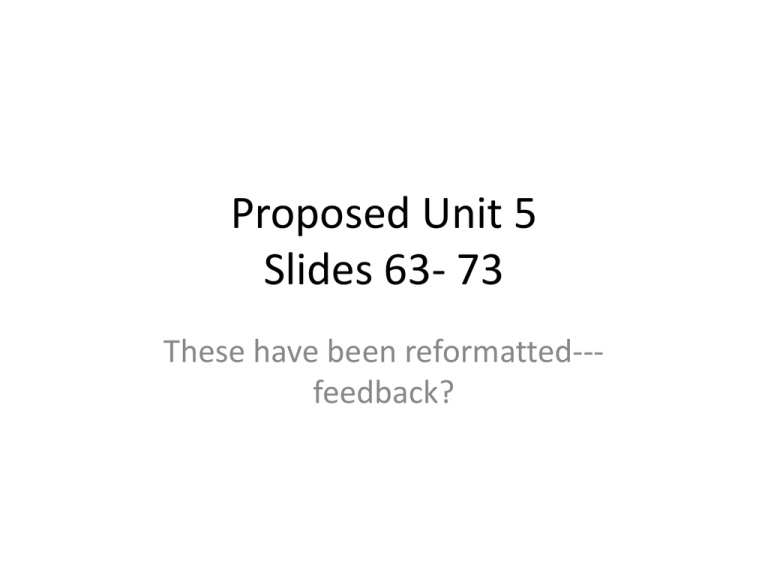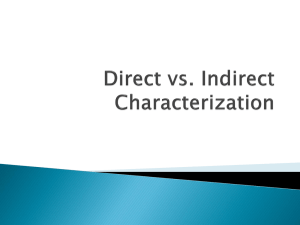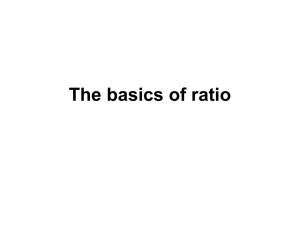Proposed Unit 5 Update to Structures
advertisement

Proposed Unit 5 Slides 63- 73 These have been reformatted--feedback? Structures of Addition How many altogether? Join and Part-Part Whole – There is something, and you get more of it? – There are two kinds, how many all together? ? Start Unknown – Some are given away, some are left, how many were there to start? ? What did I start with? Taken Left Compare--total unknown - I know one amount and I have some amount more than that--how many do I have? ? How many do I have? Addition types Adapted from Carpenter, Fennema, Franke, Levi and Empson, 1999, p. 12 in Adding it Up, NRC 2001. Structure 3 types of subtraction Ask yourself if a problem is a subtraction problem— Does it fit one of these three types?: You’ve got some amount and “take away” from it: What’s left? ? – The Classic “Take away” (how many left?) ? – Comparison (difference between? who has more?) You compare to see: Who has more or less? ? – Deficit/Missing amount (what’s missing?) You need some more to get where you want to be: What is the missing amount? Addition Start Unknown Julie had a bunch of fruit. She gave away 30 oranges and she still has 50 pieces of fruit left. How many pieces of fruit did she have to start with? ? Subtraction Classic “take-away” Julie had 80 pieces of fruit. She gave away 30 oranges. How many pieces of fruit did she have left? ? 30 50 30 ? left + gave away =start ? 80 start - gave away = left start – left = gave away gave away + left = start addend + addend = Sum(Total) Sum(Total) – addend = addend minuend – subtrahend = difference Addition Join or Part/Part -Whole Julie had 50 apples and then bought 30 oranges. How many pieces of fruit does she have now? Subtraction Deficit/ Missing Amount Julie wanted to collect 80 pieces of fruit for a food drive. She already has 50 apples. How many more pieces of fruit does she need? ? ? ? 30 50 50 ? part + other part = whole addend + addend = sum 80 whole – part = other part whole – part accounted for = part needed whole – part = difference minuend – subtrahend = difference Addition Compare: Total unknown Julie had 30 oranges and some apples. She had 20 more apples than oranges. How many apples does she have? Subtraction Compare: difference unknown Julie had 50 apples and 30 oranges. Does she have more apples or oranges? How many more? ? 50 ? 20 30 30 ? 20 30 ? Amount of one set + the difference between two sets = amount of second set Addend + addend = sum total (of unknown set) 30 50 Amount in one set – amount of an other set = difference between sets sum total (needed) – amount of one set (have) = difference STRUCTURE: 3 Types of Multiplication: 4 x 3 Repeated Addition Array/row-column Counting Principle STRUCTURE: 10 2 3 Types of Division: Measurement/Repeated Subtraction “How many 2s can I get out of 10?” 2 2 10 ? 2 2 2 If I have 10 cups of beans and I give out 2 cup portions, how many servings will that provide? Partitive/Unitizing/Fair Shares “How many would 1 person get? Or “What would that mean in relation to 1?” ? 10 ? If 2 people find $10 how much will each person get ? Product/Factor “If I have an area of 10 and one side is 2, how long is the other side?” 10 ? 2 Multiplication Repeated Addition Division Repeated Subtraction/Measurement Julie had 4 baskets with 5 pieces of fruit in each basket. How many pieces of fruit does she have? 5 + 5 + Julie has 20 pieces of fruit. She wants to eat 5 pieces of fruit a day. How many days can she eat her fruit? 5 + 5 -5 - 5 -5 -5 20 0 0 5 10 15 20 0 5 10 15 20 How many is 4 5s? How many 5s can you get out of twenty? # of Groups * Objects in group = Total objects Total ÷ portions = servings Product ÷ factor = factor Factor * Factor = Product Multiplication Array/Row-Column (Area/Side Length) Julie has a rectangular surface she wants to cover with square unit tiles. The length of one side is 5 units long and the length of the other side is 4 units long. How many pieces of tile does Julie need? Division Product/Factor (Area/Side Length) Julie has a rectangular surface that is 20 square units. The length of one side is 5 units long. What is the length of the other side? 1 1 2 3 4 2 3 4 5 5 1 ? 2 3 4 linear side ∙ linear side = area of rectangle row ∙ column = total factor ∙ factor = product of area area of rectangle ÷ linear side = other linear side Total ÷ column = row Total ÷ row = column Product ÷ factor = factor Multiplication Fundamental Counting Principle Julie packed 4 pair of jeans and 5 shirts for her trip. How many different unique outfits can she make? S1 S2 S3 S4 S5 J1 S1 S2 S3 S4 S5 J2 S1 S2 S3 S4 S5 S1 S2 S3 S4 S5 J3 J4 Total outfits? This is also an excellent model for probability: Julie has four dice in different colors: blue, red, green and white. If she picks one die at random and then rolls it, what are the chances that she would have rolled a blue 5? 1 2 3 4 5 6 blue 1 2 3 4 5 6 red green 1 2 3 4 5 6 white 1 2 3 4 5 6 Division Partitive/Unitizing/Fair Shares Julie is packing her suitcase for a trip. She is planning her outfits for the trip and will wear one shirt and one pair of jeans each day. She brought 5 shirts. How many pairs of jeans must she bring if she needs 20 unique outfits? S1 S2 S3 S4 S5 S1 S2 S3 S4 S5 S1 S2 S3 S4 S5 5 outfits 10 outfits 15 outfit S1 S2 S3 S4 S5 20 outfits This model is the way students first learn division, through ‘fair shares’? How many will each one person get? It is also the structure for a Unit Rate: 20 per every 4, how many per 1? D1 D5 D9 D13 D17 n1 D2 D5 D10 D14 D18 n2 D3 D7 D11 D15 D19 n3 D4 D8 D12 D16 D20 n4 Julie has 20 dollars and wants to give out the money equally among her four nieces. She passes the dollars out to them one at a time. How much will each niece get?








